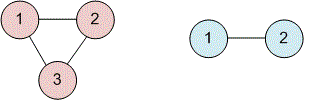Editorial
The problem provides an undirected connected graph. It is necessary to check whether it contains a cycle (which can be turned into a Formula-0 track).
An undirected graph contains a cycle if there is a back edge, i.e., an edge leading to a vertex that is already visited.
Example
The graphs given in the example are as follows:

The first graph contains a cycle, while the second does not.
Algorithm realization
The graph is stored in the adjacency matrix . The array used is used to mark the visited vertices.
#define MAX 1010 int g[MAX][MAX], used[MAX];
The dfs function implements depth-first search from vertex . It is necessary to exclude the case when we move from to its ancestor: the ancestor is already visited, but there is no cycle. To handle this, we will introduce a second parameter in the dfs function, representing the ancestor of vertex .
void dfs(int v, int p = -1)
{Mark vertex as visited.
used[v] = 1;
Iterate over the vertices that can be reached from .
for (int i = 1; i <= n; i++)
{Consider all edges except for the one that leads to the ancestor .
if (i == p) continue;
If there is an edge from to , and is already visited (), then the graph contains a cycle. Set .
if (g[v][i] == 1)
{
if (used[i] == 1) flag = 1;Otherwise, continue the depth-first search from vertex .
else dfs(i, v);
}
}
}The main part of the program. Read the input data.
scanf("%d %d",&n,&m);
memset(g,0,sizeof(g));
memset(used,0,sizeof(used));Read the input undirected graph. The graph is stored in an adjacency matrix, so repeated roads will be counted only once.
for (i = 0; i < m; i++)
{
scanf("%d %d",&u,&v);
g[u][v] = g[v][u] = 1;
}Set , which indicates the absence of a cycle in the graph. If a cycle is found, the value of will change to .
flag = 0;
Initiate depth-first search from vertex (according to the problem statement, the graph is connected).
dfs(1);
Based on the value of , print the result.
if (flag) printf("YES\n");
else printf("NO\n");Java realization
import java.util.*;
public class Main
{
static int g[][], used[];
static int n, m, flag;
static void dfs(int v, int prev)
{
used[v] = 1;
for(int i = 1; i <= n; i++)
if ((i != prev) && g[v][i] == 1)
if (used[i] == 1) flag = 1; else dfs(i,v);
}
public static void main(String[] args)
{
Scanner con = new Scanner(System.in);
n = con.nextInt();
m = con.nextInt();
g = new int[n+1][n+1];
used = new int[n+1];
for(int i = 0; i < m; i++)
{
int u = con.nextInt();
int v = con.nextInt();
g[u][v] = g[v][u] = 1;
}
flag == 0;
dfs(1,-1);
if (flag == 1) System.out.println("YES");
else System.out.println("NO");
}
}